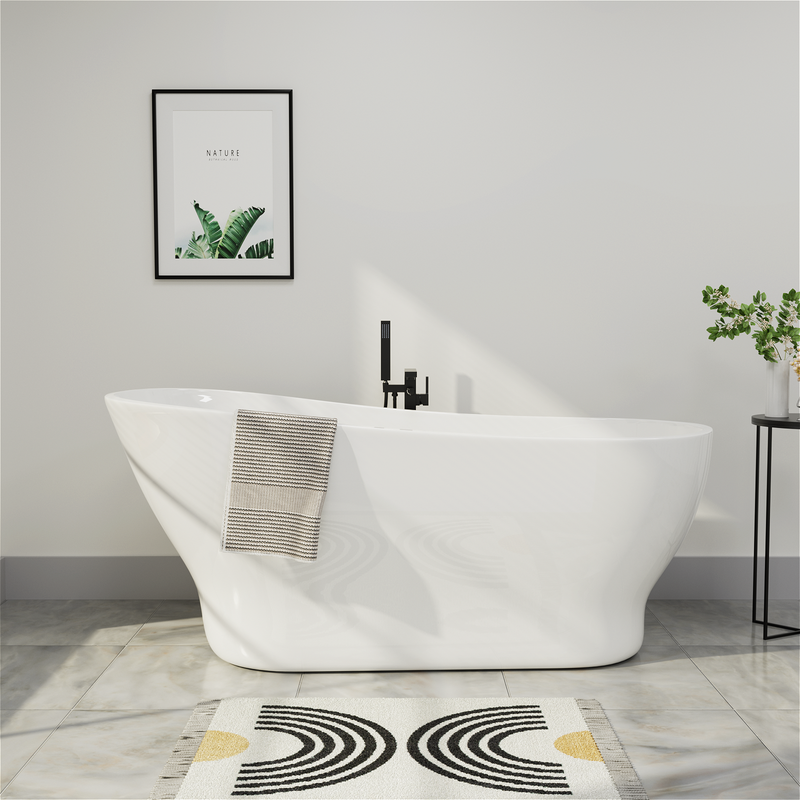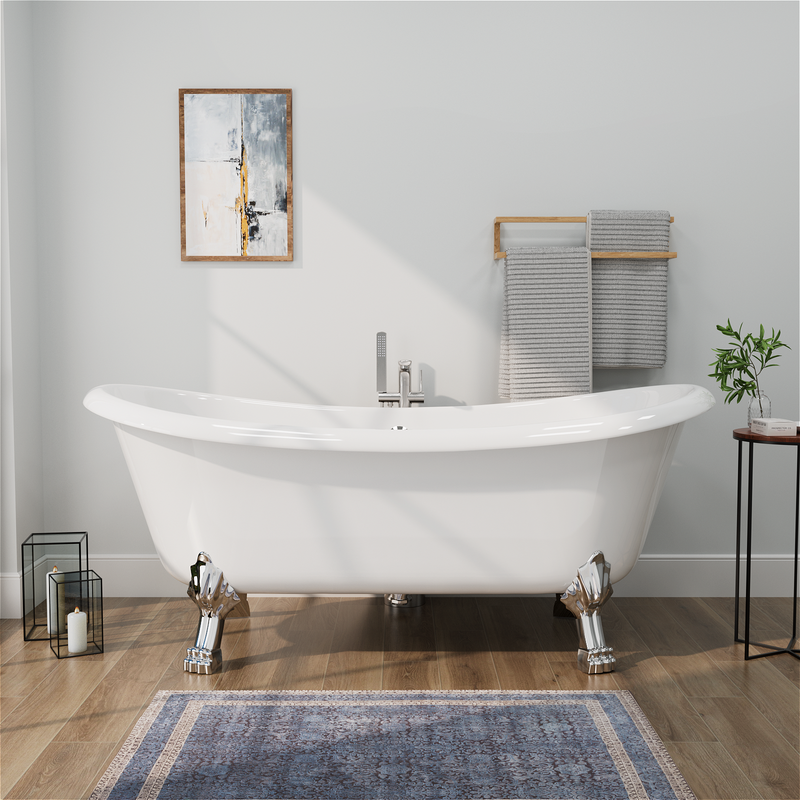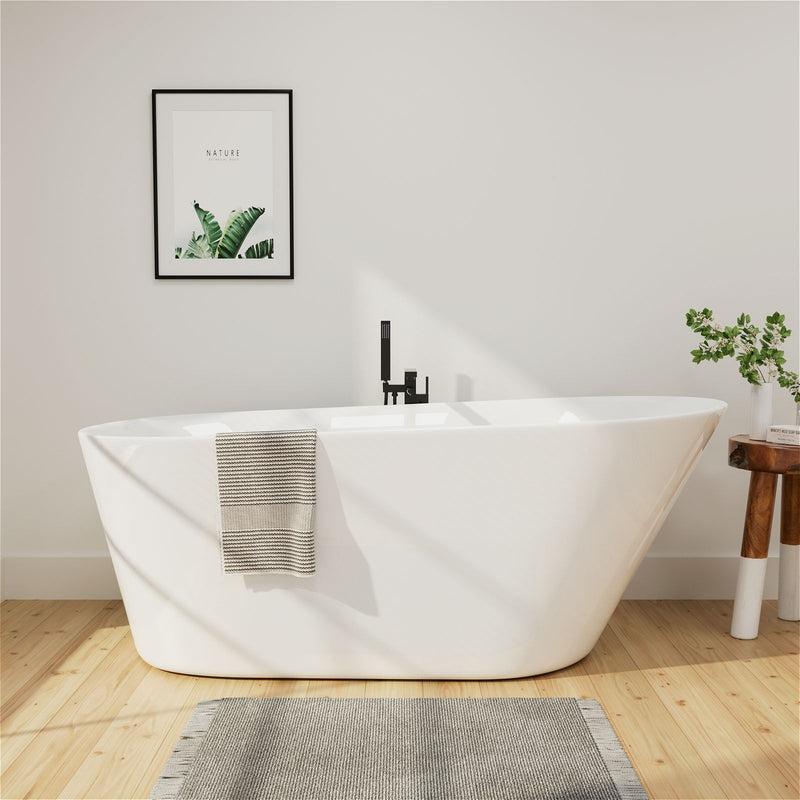The desire for a relaxing bathing experience isn't limited by bathroom dimensions. Modern freestanding bathtub for small bathroom designs prove that even the most compact spaces can accommodate elegant soaking solutions. Gone are the days when small bathrooms forced homeowners to compromise on style or comfort. Today's compact freestanding tub options combine space-efficient footprints with ergonomic designs, delivering full-body immersion in bathrooms where every square inch counts. This guide will help you navigate the world of small-space bathing solutions, ensuring you select a tub that enhances your daily routine without overwhelming your limited square footage.
Finding the Right Size for Your Compact Bathroom
Understanding Compact Bathtub Dimensions
Selecting the proper size represents the most critical step when choosing a freestanding bathtub for small bathroom installations. While standard bathtubs typically measure 60 inches or more in length, compact bathtubs are available in significantly smaller dimensions. The smallest freestanding tubs can measure as little as 47 inches in length, though most compact bathtubs range between 59-63 inches. These reduced-length tubs often compensate with greater depth, allowing for satisfying immersion despite their shorter footprint.

Width represents another important consideration for space-constrained bathrooms. While standard tubs often measure 30-32 inches wide, slimline compact freestanding tub designs can be as narrow as 25-27 inches, preserving valuable floor space. This reduction in width can make a substantial difference in narrow bathrooms where passage space around the tub is limited. When measuring your bathroom, remember to account for at least 24-31 inches of clearance around all sides of the tub for access, cleaning, and visual balance.
Size Guidelines for Different Bathroom Layouts
The following size recommendations can help you match tub dimensions to your available space:
- For very small bathrooms (under 40 square feet): Consider compact tubs measuring 47-55 inches in length and 25-27 inches in width. These space-saving bathtubs can often fit where traditional tubs would overwhelm the room.
- For moderate-sized bathrooms (40-60 square feet): Standard compact tubs ranging from 59-63 inches in length and 27-30 inches in width typically work well, providing comfortable soaking without dominating the space.
- For irregular layouts: Corner placement options or uniquely shaped tubs (such as oval designs) can sometimes maximize space utilization in challenging bathroom configurations.
Always measure your specific bathroom space before selecting your tub, accounting for door swings, existing fixtures, and traffic patterns. Creating a simple floor plan with cut-to-scale paper templates can help visualize how different tub sizes will fit within your existing layout.
Optimal Materials for Space-Efficient Bathtubs
Why Acrylic Reigns Supreme for Compact Bathrooms
When selecting a freestanding bathtub for small bathroom settings, material choice significantly impacts both performance and practicality. Acrylic emerges as the ideal choice for several compelling reasons. First, its lightweight nature simplifies installation, particularly important in upper-story bathrooms or spaces with limited access. Unlike heavier materials like cast iron, acrylic tubs can be maneuvered more easily through narrow hallways and doorways.
The heat retention properties of acrylic ensure bathwater stays warmer longer, maximizing your soaking enjoyment. This material feels warm to the touch immediately upon contact, unlike metals that can feel cold initially. For small bathrooms where every impression counts, this immediate comfort enhances the bathing experience from the moment you step in.

From a maintenance perspective, acrylic's non-porous surface resists staining and enables easy cleaning with just a soft cloth and mild, non-abrasive cleaners. The durability of quality acrylic reinforced with fiberglass ensures these tubs withstand years of regular use while maintaining their appearance. For homeowners seeking a balance of affordability, performance, and ease of installation, acrylic represents the clear value leader among bathtub materials.
Alternative Material Considerations
While acrylic offers numerous advantages for compact bathrooms, other materials may suit specific preferences or design schemes. Solid surface options provide exceptional durability and a seamless appearance, though they typically command a higher price point. Their non-porous nature resists stains and bacteria, an advantage for households with cleanliness priorities.
Regardless of material selection, prioritize quality construction and appropriate reinforcement. Well-made tubs of any material should feel substantial and stable, without excessive flexing or movement during use. The material's finish should be smooth, consistent, and free of imperfections that might compromise durability or cleaning ease.
Shape Considerations: Maximizing Your Limited Space
Oval Versus Rectangular Designs
The shape of your compact freestanding tub significantly influences both aesthetics and spatial efficiency. Oval tubs feature gracefully curved sides that can make small bathrooms feel more fluid and organic. Their symmetrical shape works well as a visual centerpiece and often provides comfortable, body-conforming interiors that enhance the soaking experience. The continuous curves of oval designs can help visually soften angular bathrooms, creating a more inviting atmosphere.
Rectangular tubs offer a different set of advantages for small spaces. Their straight lines and defined angles can create a crisp, modern aesthetic that emphasizes order and efficiency. From a practical perspective, rectangular tubs often maximize interior soaking space within a given footprint, providing more shoulder and leg room than similarly sized curved alternatives. Their straight edges can also be positioned closer to walls, potentially conserving a few precious inches in tightly planned layouts.
Space Utilization Differences
When evaluating shape options, consider how each interacts with your bathroom's existing architecture. Oval tubs generally work better as room centerpieces or positioned with clearance on all sides, while rectangular bathtubs can be nestled more snugly against walls or into corners. The curved exterior of oval tubs can create awkward, unused slivers of space in tight corners, whereas rectangular tubs utilize corner placements more efficiently.

Your choice between oval and rectangular ultimately depends on your spatial constraints versus your aesthetic preferences. Homeowners prioritizing softness and visual flow may prefer oval designs, while those seeking to maximize every square inch might lean toward rectangular options. If possible, view both shapes in person to better understand how each might feel in your space.
Strategic Installation Placement Ideas
Wall and Corner Placement Options
Strategic placement can make even a generously sized freestanding bathtub for small bathroom settings feel appropriately scaled. Positioning your tub against a wall represents the most space-efficient approach, creating a built-in look while conserving floor area. This placement simplifies plumbing connections and may allow for a narrower clearance zone on the wall side, potentially saving 6-12 inches of valuable floor space.
Corner installations offer another space-smart solution, utilizing often-underemployed areas of the bathroom. Angling a tub into a corner can create interesting visual dynamics while maximizing open floor area for movement and other fixtures. This approach works particularly well with clawfoot tubs that have attractive sides worth displaying or oval tubs whose curves complement angular room configurations.
Replacement and Integration Strategies
Many homeowners successfully incorporate a compact freestanding tub by replacing a bulky built-in bathtub. This switch can actually make the bathroom feel more spacious by eliminating enclosing walls and creating visible floor space beneath and around the tub. The visual continuity of floor surface extending underneath the tub creates an impression of more room, even when the tub's footprint is similar to the previous built-in bathtub.
For bathrooms where space is extremely limited, some homeowners opt to replace a shower enclosure with a freestanding tub, using a shower-tub combination setup. This approach requires careful planning for water containment but can provide both bathing options in a single footprint. Adding a shower to a freestanding tub requires a ceiling-mounted shower rod or circular enclosure and careful attention to waterproofing surrounding surfaces.
Addressing Practical User Concerns
Heat Retention and Water Temperature
Nothing diminishes the enjoyment of a bath more quickly than rapidly cooling water. Fortunately, modern freestanding bathtub for small bathroom designs address this concern through both material selection and design refinement. Acrylic tubs naturally insulate better than metal alternatives, slowing heat transfer and maintaining comfortable water temperatures throughout your soak. The thicker construction of quality tubs provides additional insulation, while some manufacturers incorporate extra thermal layers in their construction process.
Beyond material considerations, simple behavioral adjustments can extend your bathing comfort. Pre-warming the tub with hot water before filling for your bath establishes a warmer base temperature. Keeping the bathroom door closed during your bath minimizes drafts that accelerate heat loss. For those in particularly cold climates, positioning the tub away from exterior walls or drafty windows can also help maintain water temperature.
Splash Control and Water Management
In compact bathrooms where fixtures sit in close proximity, water management becomes increasingly important. The deeper soaking depths of many compact tubs naturally help contain water, with higher sides preventing excessive splashing. Positioning the tub away from vulnerable elements like wooden cabinetry or electrical outlets provides an additional layer of protection against accidental water exposure.

Bathmats placed alongside the tub can protect flooring from drips when entering and exiting, while properly sized shower curtains (for tub-shower combinations) should extend several inches beyond the tub perimeter to contain spray effectively. For freestanding tubs used exclusively for bathing, a handheld showerhead or dedicated rinsing fixture positioned directly above the tub minimizes water movement around the bathroom.
Cleaning and Maintenance Simplicity
Keeping your compact freestanding tub looking its best requires understanding its specific maintenance needs. Acrylic surfaces demand non-abrasive cleaners and soft cloths to prevent surface scratching that can cloud appearance over time. Immediate wiping after use prevents soap scum and hard water deposits from establishing, reducing the need for deep cleaning sessions.
The accessibility of freestanding tubs simplifies exterior cleaning compared to built-in bathtubs. Without corners where tub meets wall, you eliminate a common mold and mildew accumulation point. Regular cleaning beneath the tub prevents dust and debris buildup in this easily overlooked area. For tubs with exterior finishes, following manufacturer recommendations for cleaning products preserves their appearance and protects against damage.
Mokleba Recommendations for Space-Constrained Bathrooms
Compact bathtub Selection Guide
Mokleba offers several freestanding bathtub for small bathroom options that balance form, function, and spatial efficiency. Our 47” Japanese soaking tubs provide comfortable soaking in a compact footprint, with sufficient depth for shoulder-level immersion. The classic rectangular shape works well in various bathroom styles, from traditional to contemporary, while the acrylic construction ensures manageable weight for installation.
For even more constrained spaces, the 47” rectangular tubs offer a space-optimized design that can be positioned directly against walls or in corners. The straight sides maximize interior dimensions within the external footprint, while the textured bottom provides secure footing. These bathtubs work particularly well in narrow bathrooms where clearance on one or more sides may be limited.
Selection Considerations for Different Needs
When choosing between Mokleba's compact bathtubs, consider your primary bathing preferences. Those who enjoy reclining while soaking may prefer the body-conforming curves of oval designs, while bathers who sit more upright might appreciate the straight back support of rectangular options. Also consider installation practicalities—the lightweight nature of acrylic tubs makes them suitable for upper-floor bathrooms without requiring structural reinforcement.
Your choice of faucet can also impact spatial dynamics. Wall-mounted faucets preserve floor space around the tub, while floor-mounted options create a more dramatic statement but require additional clearance. Coordinating your drain finish with other bathroom hardware creates a cohesive look that enhances the overall aesthetic of your compact bathroom.
Making Your Final Selection
Choosing the ideal freestanding bathtub for small bathroom settings requires balancing multiple considerations: available space, bathing preferences, aesthetic goals, and practical realities. By carefully measuring your bathroom, understanding material properties, and selecting a shape that complements your spatial constraints, you can identify a tub that enhances both your bathroom's functionality and its visual appeal.
The compact freestanding tub options available today demonstrate that limited square footage need not limit your bathing satisfaction. With strategic placement and appropriate sizing, these space-efficient designs deliver the comfort and style of their larger counterparts while respecting the realities of compact living. Your perfect bathing experience awaits—it's simply a matter of selecting the right tub to bring it to life in your home.
FAQs
Q1: What is the smallest possible freestanding tub size?
A: The most compact freestanding tubs measure approximately 47 inches in length and 25 inches in width, though these very small bathtubs may require careful consideration of user height and comfort needs. Most adults find tubs of 55 inches or longer provide more comfortable soaking experiences.
Q2: Are freestanding tubs practical in very small bathrooms?
A: Yes, with proper planning. Compact freestanding tubs can actually make small bathrooms appear larger by revealing more floor surface. Their flexibility in placement often allows for better traffic flow than built-in alternatives.
Q3: Which material is best for easy maintenance in a small bathroom tub?
A: Acrylic offers the simplest maintenance routine, requiring only soft cloths and non-abrasive cleaners. Its non-porous surface resists stains and mildew, and its lightweight nature simplifies installation.
Q4: How much clearance space should I leave around a freestanding tub?
A: Industry recommendations suggest 24-31 inches of clearance on all sides for safe access and cleaning, though this may be reduced to 15-18 inches on some sides in very compact bathrooms if proper access is maintained.
Q5: Can I install a freestanding tub myself?
A: While freestanding tubs are generally simpler to install than built-in bathtubs, proper installation remains essential—ensure the floor is level and connect drainage properly. The lightweight nature of acrylic bathtubs makes them more suitable for DIY installation than heavier materials.
Q6: Do freestanding tubs hold heat as well as built-in bathtubs?
A: Acrylic freestanding tubs typically provide excellent heat retention, often superior to steel built-in bathtubs. The material's natural insulation properties help maintain water temperature throughout your bath.
Q7: Are there specially shaped freestanding tubs for corner placement?
A: While most freestanding tubs are oval or rectangular, some compact bathtubs feature asymmetrical designs that optimize corner placement. Alternatively, standard oval tubs can be angled into corners to create interesting spatial dynamics.





